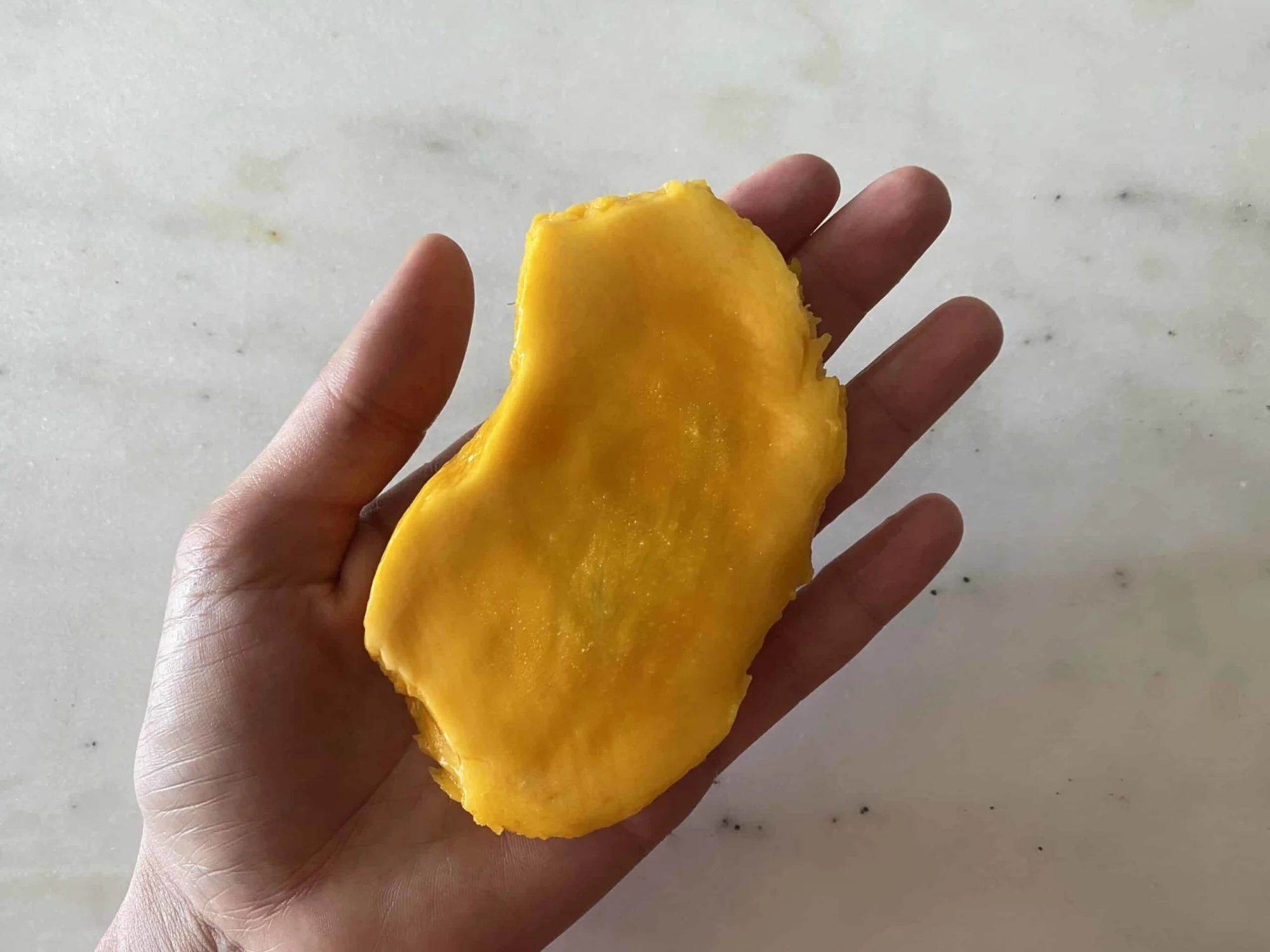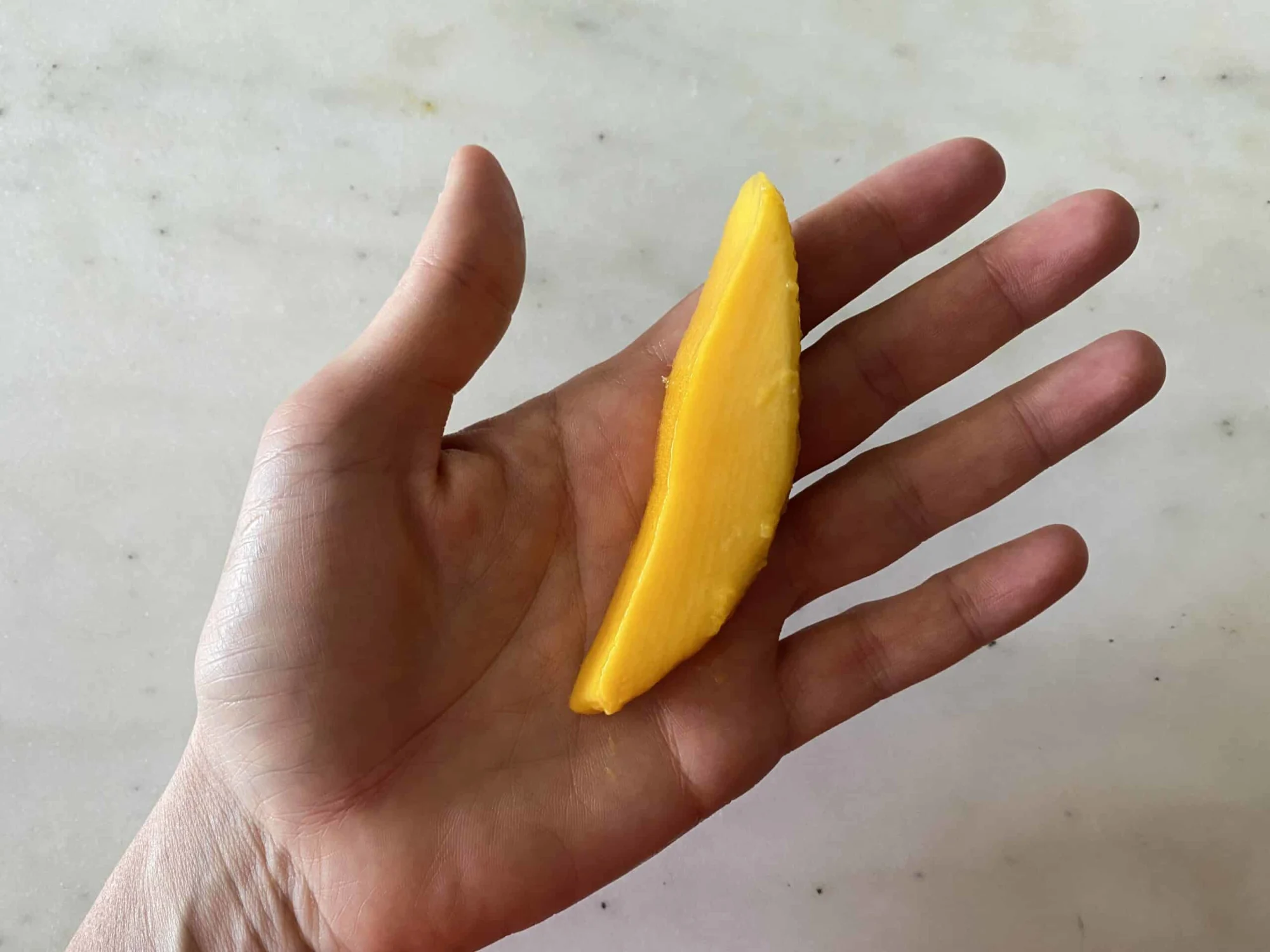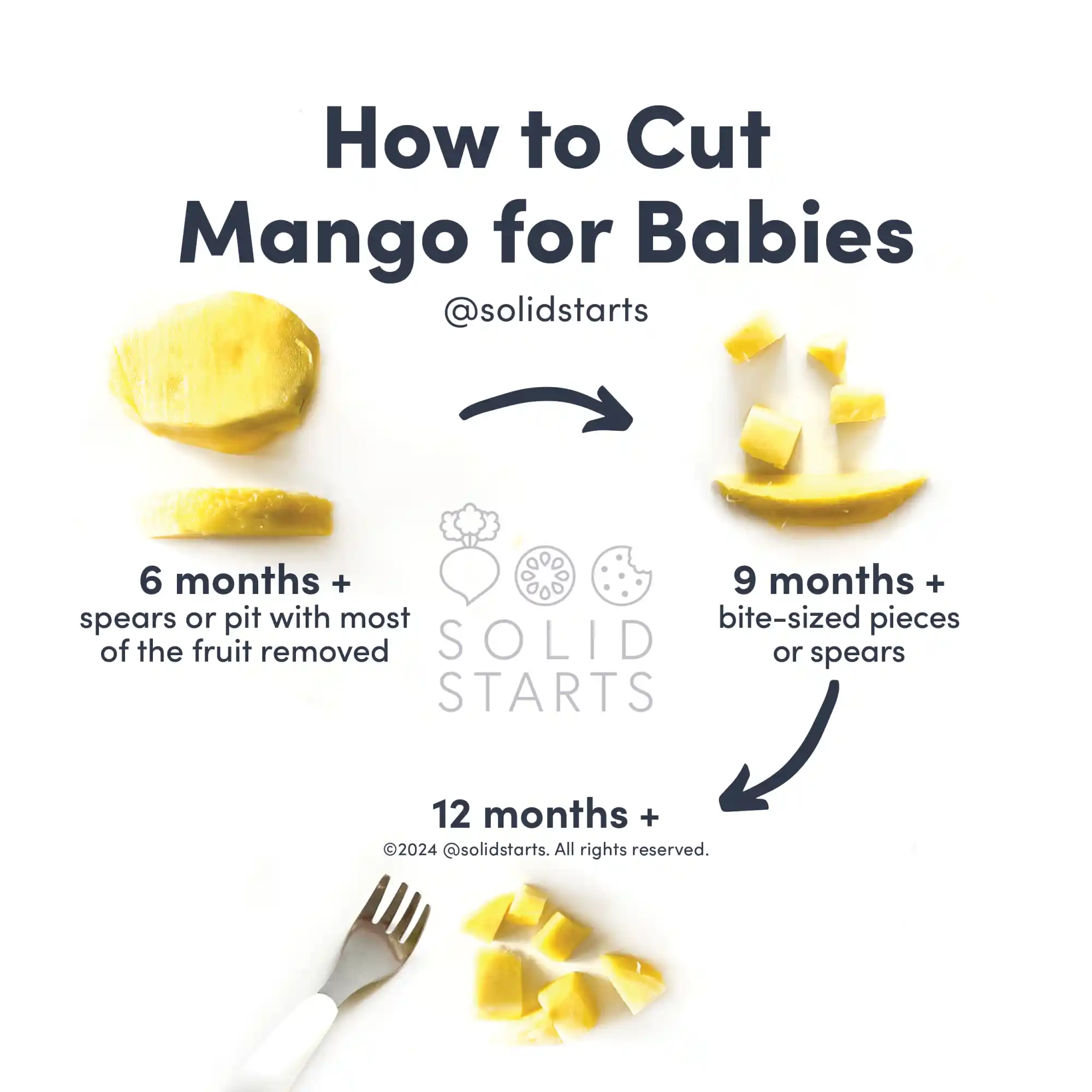Access our First Foods® Database in the Solid Starts App.
Learn moreMango
Fruit
Age Suggestion
6 months
Iron-Rich
No
Common Allergen
No

When can babies have mango?
Mangoes may be introduced as soon as baby is ready to start solids, which is generally around 6 months of age.
Mango is a stone fruit that originated in South Asia and now grows in tropical climates around the world. There are more than 500 known varieties of mango, including the Tommy Atkins, with greenish-red skin and golden flesh; the honey or Ataúlfo mango, a smaller fruit with sweet and sour flavor; and the Kesar mango, a round, sweet variety.
How do you serve mango to babies?
Every baby develops on their own timeline, and the suggestions on how to cut or prepare particular foods are generalizations for a broad audience.
6 months old +:
A whole mango pit—peeled and with most of the flesh removed—is a great resistive food for this age, offering a low-risk way for babies to build oral motor skills and learn about the boundaries of their mouth. If the mango pit keeps slipping out of baby’s hands, roll it in foods like grated coconut, finely ground nut, or even dry infant cereal to add grip. Alternatively, you can serve minced mango atop scoopable foods like yogurt or ricotta or mango spears. Make sure the mango is ripe enough that it mashes readily when pressed gently between your thumb and pointer finger. Simply peel the mango, cut the flesh from the pit, and slice the flesh into long spears. Handing the spear in the air to baby will help them get ahold of the fruit.
9 months old +:
Continue to offer whole mango pits or spears. If baby has developed their pincer grasp (where the thumb and pointer finger meet), you can also serve bite-sized pieces of mango as a finger food or on a pre-loaded fork. Make sure the mango is ripe enough that it mashes readily when pressed gently between your thumb and pointer finger. Alternatively, offer minced mango atop scoopable foods like yogurt or ricotta.
12 months old +:
Serve diced ripe mango as finger food as well as a fork to encourage utensil use. For toddlers who are learning to use utensils, coax them along by pre-spearing a piece of mango with the fork and resting the pre-loaded utensil next to the fruit for the child to try to pick up.


How to cut a mango pit for babies
How to cut a mango into spears for babies
Babies get bored with foods just like we do. Try our guide, 50 Breakfasts for Babies & Toddlers, to add some variety to your mornings.
Videos
Are mangoes a choking hazard for babies?
Yes. Mango can be firm and slippery, which are qualities that increase the risk of choking. To reduce the risk, prepare and serve mango in an age-appropriate way. As always, make sure you create a safe eating environment and stay within an arm’s reach of baby during meals.
Learn the signs of choking and gagging and more about choking first aid in our free guides, Infant Rescue and Toddler Rescue.
Is mango a common allergen?
No. Allergies to mango are rare, though individuals who are allergic to latex or pollens (birch, grass, mugwort, and ragweed) may also be allergic to mangoes. Although cross-reactivity has been noted between cashew, pistachio, and mango seed, this does not extend to mango pulp. Therefore, it's generally safe to give cashew- or pistachio-allergic babies cut or mashed mango pulp. However, you may not want to give them the pit to gnaw on.
Mango sap (found in the skin) does contain a chemical that cross-reacts with urushiol, the chemical responsible for contact dermatitis from poison ivy and poison oak. Individuals sensitive to urushiol may experience skin reactions when handling mango skin, but the edible flesh of the mango should not produce such a reaction.
As with all new foods, introduce by serving a small quantity and watch closely as baby eats. If there is no adverse reaction, gradually increase the quantity over future servings.
Are mangoes healthy for babies?
Yes. Mangoes are rich in carbohydrates, fiber, and fluid, in addition to vitamins A, B6, C, E, and K. It also offers potassium, folate, and numerous antioxidants. Together, the nutrients work together to provide energy to fuel baby’s play and development, support digestive health, and aid in hydration. These nutrients also support vision, metabolism, immune function, electrolyte balance, nervous system functioning, and bodily repair and recovery.
★Tip: Add grip to slippery fruit like mangoes by rolling the spears in crushed whole grain cereal, finely-grated coconut, or finely ground nuts or seeds.
Can babies eat dried mango?
No. It is best to hold off on serving dried mango until closer to age 2 unless it is under the supervision of a feeding therapist or swallowing specialist (dried mango is often used in feeding therapy to build chewing skills). Dried fruit in general can increase the risk of choking and often contains sulfites and other preservatives. If all you have is dried mango, simply rehydrate the dried mango pieces in water and chop.
Can babies eat green (unripe) mango?
Yes, but caution is recommended if offering it, as it could be a choking hazard when presented in cubes as it is firm in texture. Safer alternatives include offering the whole mango pit for baby to teethe on, thin strips (julienned), amchur powder (dried, ground green mango), and chutneys (no honey). Unripe mango is high in vitamin C and has a sour taste. Babies in particular may experience gas and bloating due to the high levels of raw starch in uncooked unripe mango, so start with small quantities first.
When can babies drink mango juice?
Wait to serve pasteurized mango juice as a drink until after 12 months of age. Note that it can be beneficial to wait until after a child's 2nd birthday to regularly share juice and other sugary drinks. Research suggests that regular intake of juice and other sweet drinks tends to increase the risk of dental cavities and take up space in the belly, which may decrease a child’s motivation to eat other foods at mealtime and may negatively affect the child’s growth. However, occasional, small servings of juice after one year of age generally isn’t a cause for concern. Learn more about serving juice to babies and toddlers.
Our Team
Written by
Expert Tips Delivered to Your Inbox
Sign up for weekly tips, recipes and more!
Copyright © 2025 • Solid Starts Inc







